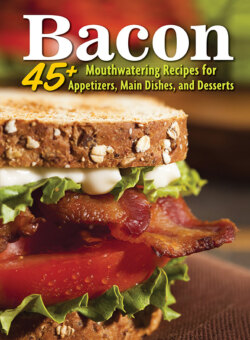Читать книгу Bacon - Группа авторов - Страница 7
На сайте Литреса книга снята с продажи.
diggin’ into BACON?
ОглавлениеHow much do you know about the common styles of this pork product?
BY JENNIFER MACKENZIE
it’s difficult just to call all cured pork belly “bacon.” Many elements — from the cut to the processing, curing, flavoring and smoking (or lack thereof) — create different characteristics, making different styles. Let’s explore some of the most common styles of pork bacon.
O-S-C-A-R: Bavarian immigrant Oscar Mayer first sold pre-sliced, packaged bacon in 1924.
Traditionally a slab of pork belly is cured with dry rub.
A dry rub or dry cure preserves the meat by removing moisture.
Side bacon (also called regular, standard or American bacon; streaky bacon in Britain): Traditionally a slab of pork belly is cured with a dry rub, which generally consists of salt, nitrites (may or may not be used), sugar and/or honey or maple syrup, and spices for several days to draw moisture out of the meat, helping to preserve it. This also infuses the meat with flavor. The slab is then hung, or set out on racks to dry, followed by smoking at a moderately low temperature, which enhances the flavor, adds the characteristic smoky taste and has a preserving effect.
Commercially made bacon is commonly wetcured by injecting brine into the pork belly, technically called “pumping.” Less commonly, the belly might be immersed in brine. Both methods add water to the salt, nitrites and spices — which speeds up the curing process and bulks up the weight. The U.S. Department of Agriculture’s Food Safety and Inspection Service sets limits for the amount of added liquid that can remain in the cured pork. Instead of heat smoking, the cured belly is sprayed with liquid smoke derived from smoldering wood chips. This product has a much higher water content, and the yield of cooked bacon is much lower than the drycured, naturally smoked product.
Side bacon is generally sold in slices, also called strips. Thin-cut bacon yields about 35 slices per pound, while regular-cut bacon yields 16 to 20 slices per pound. Typically side bacon is half to two-thirds fat by weight. High-quality side bacon has long strips of pink meat interspersed with fat streaks.
Slab bacon: Before it is sliced, slab bacon is sold as a slab, or a piece of the slab. This cut is handy for recipes that use diced pieces, lardons or large chunks.
Center-cut: Regular side bacon is cut from the whole belly, while center-cut bacon uses only the meatier, center section of the belly, resulting in a higher-quality bacon with a higher proportion of meat to fat.
Thick-cut: premium side bacon that yields 12 to 16 slices per pound
The Smoke
Different smoking techniques and woods used for smoking add distinct flavors to bacon. These are some of the most common treatments.
Double-smoked bacon is smoked as usual, then cooled and smoked again. This adds a deep smoky flavor and is particularly good for use in recipes where you want a rich smokiness. Home bacon makers and specialty smoke houses also do triple-smoked bacon.
Peameal bacon now is known as “sweet pickled pork loin” in Canada.
Commercially made bacons is commonly wet-cured by injecting brine into the pork belly.
Hickory gives a sharp, woody smoke flavor to bacon, while applewood and cherrywood give a mellow and sweet smokiness. Maple bacon might be cured with maple syrup and/or smoked over maple wood or processed with added maple wood flavor. Some commercially prepared brands use artificial maple flavor. Maple adds a sweet element to the salty, smoky bacon.
Other Varieties
Lower-sodium: Cured with less salt, and often less sugar, it typically has about 30 percent lower sodium content than regular bacon.
“Uncured” or “natural”: Often labeled as “natural,” uncured bacon is made without added nitrites but does have nitrite-containing naturally ingredients. This bacon must be labeled with “no nitrates or nitrites added except for those naturally occurring in ingredients such as celery juice powder, parsley, cherry powder, beet powder, spinach, sea salt, etc.” The flavor does tend to be milder than conventionally cured bacon.
Other Cuts
Canadian bacon (also called back bacon): boneless pork loin trimmed of all visible fat, shaped into a round, then cured and smoked. More like ham than side bacon, this very lean type is a popular item on pizza and eggs Benedict.
Peameal bacon: This is boneless pork loin pickled in a salt brine and characterized by the bright pink meat surrounded by a thin layer of fat and vibrant yellow crust of cornmeal. The coating used to be made from peas, thus the name. In Canada, this product now must be labeled “sweet pickled pork loin” and is not called bacon. Peameal bacon is sold as chunks of the loin or in thin slices.
English bacon: boneless pork loin with a generous trim of fat that is cured and smoked. This is a fairly lean, meaty cut sold as chunks of the loin or in slices. The slices in Britain are called “rashers.”
Pancetta: Italian bacon made from pork belly and cured similarly to side bacon but not smoked. The pork belly is rolled, jelly-roll style, into a cylinder before curing, then dried. The bacon lends a salty pork flavor without the typical smoke of other varieties. High-quality pancetta has equal parts meat and fat. It is generally sold in chunks of the cylinder or in thin slices.
A professional home economist, Jennifer MacKenzie (jennifer mackenzie.net) owns FoodWorx and creates cookbooks.
